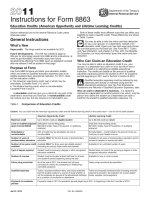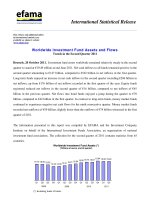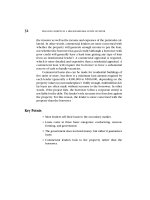dumas & choyleva - the american phoenix, and why china and europe will struggle after the coming slump (2011)
Bạn đang xem bản rút gọn của tài liệu. Xem và tải ngay bản đầy đủ của tài liệu tại đây (3.91 MB, 222 trang )
‘This brilliant book penetrates to the heart of the delusions
which still obscure the true prospects for our world’.
Peter Jay
‘Charles Dumas’ and Diana Choyleva’s reflections that Europe
and China will fall from grace and the US will re-attain it are
thought-provoking and convincing. Readers weaned on Dumas’
brand of hard-hitting analysis and no-prisoners-taken rigour will
not be disappointed.’
David Marsh, author of The Euro – The Politics of the New
Global Currency
‘A forceful global analysis that predicts a wrenching slowdown
in China and a troubled decade for Europe but greater resilience
for America’s economy over the medium term.’
Paul Wallace, The Economist
‘The tremendous global imbalances in trade and capital flows
that have emerged in the past decade - the cause of the crisis
affecting the US, Europe, China and the rest of the developing
world - are the direct result of policy distortions imposed by a
number of governments. Dumas and Choyleva and are among
the very few who have consistently understood the source of
the imbalances and now explain just why the global adjustment
is going to be so difficult, especially for surplus countries.’
Professor Michael Pettis, Guanghua School of Management,
Peking University
Praise for Globalisation Fractures
‘Thank God for Charles Dumas. He displays a true economist’s
understanding that most things in economics are the opposite of
what you would suppose – that for example the global crisis has
been as much the work of savings gluttons as of wanton debtors.’
Peter Jay
‘Unless we correctly analyse the cause of the current crisis,
we will never be able to cure it or prevent a recurrence. Most
analysis does not get beneath the symptoms, but Charles Dumas
gets to the root problem.’
Peter Lilley
‘Charles Dumas has consistently been one of the ablest
communicators on the financial crisis – a man with a nose for
danger. In characteristically acerbic style he sets out the causes
of our distress, seeks out those to blame and maps out the
escape routes. Required reading.’
David Marsh
Praise for The Bill from the China Shop
‘In 2005 Ben Bernanke argued that a global saving glut is causing
the huge US current account deficits. Charles Dumas recognised
this truth long before him. This splendid book explains how
Asia’s surpluses are driving US households ever deeper into debt
and why this unsustainable process must end in tears.’
Martin Wolf
The AmericAn Phoenix
And why ChinA And EuropE will
strugglE AftEr thE Coming slump
Charles Dumas and Diana Choyleva
First published in Great Britain in 2011 by
Profile Books Ltd
3a Exmouth House
Pine Street
London ec1r ojh
www.profilebooks.com
Copyright © Lombard Street Research 2011
The moral right of the authors has been asserted.
All rights reserved. Without limiting the rights under copyright reserved above, no part
of this publication may be reproduced, stored or introduced into a retrieval system,
or transmitted, in any form or by any means (electronic, mechanical, photocopying,
recording or otherwise), without the prior written permission of both the copyright
owner and the publisher of this book.
Typeset in Times by MacGuru Ltd
Printed and bound in Britain by
Bell & Bain Ltd
A CIP catalogue record for this book is available from the British Library.
ISBN 978 1 84668 564 4
Contents
Figures and tables vii
Acknowledgements ix
Introduction – the return of imbalances 1
1 America shakes China loose 15
2 American boom–bust, then healthy growth 31
3 China’s export-led growth model breaks down 53
4 China’s red-hot economy to slump in 2011–12 95
5 Euroland’s debt tragedy – Ireland, Club Med 129
6 German confusion and fallacies 156
7 Islands apart – Japan and Britain 174
8 Is there any hope? 182
Appendix: How much debt is sustainable? 190
Index 203
Figures and tables
Figure 1 Gross world saving, % of GDP 5
Figure 2 Gross national savings, % of GDP, and real GDP
growth 9
Figure 3 Advanced Countries financial balances,
% of GDP 11
Figure 4 Real net exports, four-quarter moving averages 16
Figure 5 Financial balances in the US economy, % of GDP 17
Figure 6 US government receipts and outlays, % of GDP 37
Figure 7 China’s national savings rate, % of GDP 62
Figure 8 China’s savings rate by sector, % of GDP 66
Figure 9 China’s current account, % of GDP 78
Figure 10 China’s consumer spending and investment, %
of GDP 79
Figure 11 China’s increase in broad money, % of GDP 97
Figure 12 China’s inflation: The consumer price index
versus the GDP deflator, four-quarter change 103
Figure 13 China’s property price inflation, 12-month
change 106
Figure 14 China’s mortgages as a share of GDP 113
Figure 15 China’s utilisation of power generating
equipment 124
viii the american phoenix
Figure 16 Real short-term euro interest rates, 1999–2007
average, % 131
Figure 17 Irish GDP, real and nominal, 2007 Q4 = 100 134
Figure 18 Real GDP since the previous recession,
2001 Q4 = 100 138
Figure 19 Relative unit labour costs in manufacturing,
1998 Q4 = 100 139
Figure 20 Household debt, % of gross household disposable
income 145
Figure 21 Non-financial company debt, multiple of
EBITDA/EBIT 149
Figure 22 German real GDP and consumer spending,
2001 Q4 = 100 157
Figure 23 Output/worker-hour, whole economy, 7½-year
moving average, % pa 161
Figure 24 German personal savings, % of personal
disposable income 166
Table 1 US growth of GDP, jobs and productivity 43
Table 2 Key ratios of debt to GDP by country, 2009 144
Acknowledgements
M
ost of the ideas in this book came out of work on the global
economy for Lombard Street Research. We owe our col-
leagues a huge debt for the constant discussion and analysis of
ideas, scenarios and forecasts – particularly Brian Reading, whose
original work on the flows of funds is a primary tool employed
in this book. Brian also has helped keep the emphasis on the
damaging role of fixed or managed exchange rates – between
China and the US, and within the euro – as a vital mechanism by
which China and Germany have pursued ‘beggar-my-neighbour’
policies for the past decade. Lastly, he helped mightily by editing
the prose at key points in this book. When it comes to economic
theory, we have adopted a ‘pick and choose’ approach to the ideas
of Keynes, Schumpeter and Friedman, each of whose approaches
has great value in thinking about our new crisis, although it must
be said that Messrs Keynes and Schumpeter have come out of it
better than Friedman – unsurprising historically, as today’s prob-
lems are much close to the deflation of the 1930s than the infla-
tion of the 1970s.
Our managing director at Lombard Street Research, Peter
Allen, aside from his pithy summaries of key issues, has shown
his usual insight in helping choose the title for this book: The
x the american phoenix
American Phoenix not only catches the longer-run point that the
US is the major economy most likely to achieve trend growth
over the next five years, but also hints at the ‘ashes’ that we are
forecasting for 2012 – a renewed slump from which countries
depending on export-led growth or commodities will scarcely
recover for years. The staff of Profile Books have been monu-
ments of good humour and patience, putting up with sometimes
dilatory deliveries from the authors, and we are very grateful for
that. Lastly, we should thank our respective partners, Pauline
Asquith and Dominic Bryant, for putting up with the stress that
one inevitably lays off when writing a book.
Introduction
The return of imbalances
G
lobal financial imbalances, the fundamental cause of the
2007 –09 crisis, have not been reduced in the recovery of
2010–11, merely transformed. The build-up of debt resulting
from the new form of imbalances is just as threatening, maybe
more so, than that of 2004–07. Then, the excess of saving in the
Eurasian savings-glut countries took the world savings rate to the
highest level on record in 2006 and 2007. This excessive flow
of cash ‘crowded out’ US savings, which fell to 14% of its GDP
in 2007, versus a typical 18%-plus in the 1990s. The flip-side
of this was a build-up of overseas US deficits and internal debt,
particularly in households, leading to the subprime crisis. Now,
the global savings rate, down somewhat by 2009, is back to its
2007 level, and the imbalance has shifted to a grotesque excess
of saving by the private sector in all advanced countries, par-
ticularly the deficit countries engaged in private-sector debt pay-
down (‘deleverage’), and nationally in China. The offset to this
is huge government deficits throughout the advanced countries
and a credit-fuelled investment binge in China. These will ensure
financial, but more importantly economic and political, crises and
stress throughout the world over the next few years.
The mechanism by which the 2004–07 imbalances arose
2 the american phoenix
was fixed or quasi-fixed exchange rates, specifically China’s
yuan–dollar peg and Euroland’s Economic and Monetary Union
(EMU). The great policy discovery of the 1970–2000 period
was that free trade and capital movements, with all the benefits
they have brought, are only consistent with national autonomy
if exchange rates float freely. There has been much loose talk
recently about the need for a ‘new Bretton Woods’. As Bretton
Woods was a fixed exchange-rate system, this is precisely what
the world does not need. It is through the partial return to fixed
exchange rates, with China pegging the yuan to the dollar in
1994 and the arrival of the euro in 1999, that the interactions
of what should be autonomous economies have been distorted,
resulting in unsustainable imbalances. What the world needs is
a return to ‘anti-Bretton Woods’ – floating rates except where
countries linked by fixed rates have genuinely and willingly given
up national autonomy. This condition does not and cannot exist
between China and the US, and in Europe coordination of policy
and behaviour occurs ‘more in the breach than the observance’:
for all the pious talk it is doubtful that Germans want to be like
Greeks or Greeks like Germans.
The chief message of this book will be that the US has found
a way of making China suffer more for its adoption of a managed
yuan–dollar exchange rate than it would have if it had allowed the
yuan to float upward. China is discovering the painful reality that
the forced combination of China and the US in a common cur-
rency zone – imposed unilaterally by China – is deeply destruc-
tive. China’s unprecedented monetary stimulus that kick-started
its economy in 2009 has led more to inflation than to a sustainable
boost to growth. Without buoyant US consumer growth, China’s
muscle-bound focus on low-value exports and over-investment
the return of imbalances 3
undermines its fast-growth trend. Meanwhile, America’s tem-
porary 2011 reflation has exacerbated China’s inflationary prob-
lems. China’s perceived ‘win–win’ via a deliberately undervalued
exchange rate is giving way to real effective appreciation through
rapid inflation – for an export-led mercantilist economy a clear
‘lose–lose’.
Beijing cannot afford the economic strains and social instabil-
ity that high inflation would most likely entail. The authorities
jumped on the brakes, pushing the economy into a sharp down-
turn. The Americans, too, will find the shift out of their exces-
sive budget deficits extremely painful, and it is likely to involve
a severe slowdown, quite possibly recession, next year. But that
adjustment will be made, and it means the end of export-led
growth as the chief mechanism of growth and development –
in China especially, but also in Europe and in other developing
countries that are unable to shift their focus from external com-
petitiveness to strong domestic demand growth.
It is the contention of this book that after 2012 America’s
vibrant and flexible market economy will enable it to ‘rise from
the ashes’ decisively. The next few years will see China struggle
to transform its growth model away from wasteful investment
towards consumer spending. The authorities will have to come
to terms with much slower growth, but the temptation to go for
growth at all cost will be strong, probably resulting in blowing
up asset price bubbles, whose eventual bursting will be painful.
Chinese average real GDP growth should still outperform that of
the US over the next five years, but the US stock market is set to
outperform China’s. Those investing in China will need a strong
stomach for what could be a rollercoaster ride.
The US consumer has been the export market of first resort
4 the american phoenix
for half a century from the 1950s, when its current account typi-
cally registered a surplus of 1% of GDP, to five years ago, when
its deficit peaked at 6% of GDP. Now down to a little over 3%
of GDP, this deficit will be replaced by what could well be over-
seas surplus again in 3–5 years, driven already by, first, major real
effective yuan appreciation as a result of rapid Chinese inflation
and, second, America’s incipient budgetary retrenchment. Self-
righteous Asian and European observers have excoriated American
borrowing habits: they should be wary of what they wish for. Easy-
going US import habits have been the foundation of global growth
and emerging market development. America is indeed less power-
ful than it was. It will be cutting into rates of deficit it can no longer
afford. But for the savings-glut exporters, this will be more damag-
ing than for the US itself – just as was the 2008–09 recession.
A subsidiary message is that Euroland has condemned itself
to a doomed decade. The debt-hobbled economies of the periph-
ery (Ireland and ‘Club Med’ – Italy, Spain, Greece and Portu-
gal – certainly, and maybe Britain too) cannot expand through
domestic demand growth because of budgetary cutbacks. They
depend on expansion in Germany and the rest of the world. But
the US will be sucking demand out of the rest of the world as it
puts its own finances right. China could see its growth rate halved
to 5% from 10% as its export-led growth model is left sucking
wind. Germany, perhaps even more than China, has stubbornly
refused to accept any modification of its reliance on exports and
will also find itself running on empty, pinning its hopes as it does
on exports to China. Both will find shifting to domestically led
demand as difficult as Japan has over the past 20 years of failed
adjustment. Europe will therefore suffer a continent-wide demand
deficiency at best, and quite possibly depression.
the return of imbalances 5
History generally does not repeat itself, but those who do not
learn from history may be condemned to something worse than a
repeat. The global system of economic governance that survived
the so-called Great Recession could well break up when the per-
sistence of damaging global imbalances is revealed by the failure
of the current recovery. As the continued imbalances tip the world
back into stagnation or recession – forecast for 2012 in this book
– a new and very dangerous period of narrow nationalism is the
most likely outcome. Globalisation may no longer be ‘fractured’
– to cite the title of Charles Dumas’s book last year – it could be
broken and/or reversed.
How have imbalances re-emerged so quickly? The answer
is regrettably simple. The original 2004–07 imbalances, and
resulting 2007–09 crisis, were ultimately caused, at the level
of economic cause and effect, by excess savings in the surplus,
Figure 1 Gross world saving
% of GDP
Source: International Monetary Fund
1980
1983
1986
1989
1992
1995
1998
2001
200
4
2007
2010
2013
2016
20%
21%
22%
23%
24%
25%
26%
27%
World savings, % of GDP
IMF forecast, 2012–16
6 the american phoenix
savings-glut countries. (Disgraceful bankers’ behaviour obvi-
ously had an important instrumental role, but in the broad scheme
of things their follies and crimes related to the imbalances rather
like a drug-running ‘mule’s’ crimes relate to the basic actions of
their drug baron bosses.) Consider:
• Theworldsavingsratein2006–07, when the debt crisis peaked owing
to inadequate savings in deficit countries, was despite that the highest
on record by a large margin at 23.9% of world GDP (Figure 1).
• IntheUS,theprimarydebtorcountryandtriggerofthecrisisin
2007, growth in the six ‘good’ years of the cycle after 2001 (the pre-
vious, mild recession) averaged a mere 2.6%, compared with a long-
run average (including recessions) of 3–3¼% consistently achieved
over the previous half-century.
• Partlyasaresult,inationoverthosesixyearsaveragedalow2.7%
(2.1% excluding food and energy) and had only reached 2.9% at the
peak of the cycle in 2007, though the ruinous oil price spike from
mid-2007 took the rate temporarily out of the desired 2–3% range in
2008.
• Yet even that low growth and ination were only achieved with
a credit boom that led straight to the crisis – without that credit,
growth would have been much lower still.
• Inconventionaltermsitisthereforehardtondmajorfaultwith
Federal Reserve Board (Fed) policy in 2005–07, although the often
idiotic comments of Mr Greenspan were clearly damaging.
• Ineffect,USpolicy stabilised theworldbyoffsetting inpartthe
mounting net export surpluses resulting from mercantilist policies in
the savings-glut countries – by cutting back its savings rate it limited
the rise in global savings that could not find a profitable outlet in the
countries doing the excess saving.
the return of imbalances 7
• ItistemptingtosaythatwithouttheUSdis-savingtherecordlevel
of world savings in 2007 would have been higher still, but it is more
likely that global growth would simply have been much weaker,
and with it the level of incomes and saving lower, if not the rate of
saving.
• The excess of savings therefore ‘crowded out’ decit countries’
savings and drove up their debts via continuously low real interest
rates, provoking an unjustified asset price boom that appeared to
justify the run-up of debt and run-down of savings.
• Thepersistentlowrealinterestratesaretheconclusiveeconomic
proof that the huge upswing of credit and financial market activ-
ity generally was caused by ‘supply-push’ (excess savings) rather
than ‘demand-pull’ (a spontaneous credit boom) – the latter, had it
occurred, would necessarily have dragged up real interest rates in
free markets such as government and junk bonds, both of which saw
low and falling real yields.
• Whentheworldcollapsedintodebt-inducedrecession,thelossof
GDP was greater in Japan, China and Germany than in the US or
even Britain, clearly demonstrating how the savings-glut countries
were even more dependent upon the excessive borrowing of the
deficit countries than the latter were themselves.
Alongside the new form of global imbalances – huge private
(and Chinese) excess savings and financial surpluses offset by
dangerously large government deficits – the world gross savings
rate has rebounded from its temporary 2008–09 relapse. Versus
23.9% in 2007 falling to 21.4% in 2009, it is now back to a fore-
cast 23.8% in 2011, as shown in Figure 1, with the International
Monetary Fund (IMF) forecasting its steady ascent to a totally
unprecedented 26% by 2016. Aside from reviving unsustainable
8 the american phoenix
imbalances, this excessive flow of saving is a separate destabi-
lising factor, inducing wasteful investment, most obviously in
China.
In Chapters 3 and 4, Diana Choyleva’s analysis will dem-
onstrate how this is likely to lead to violent fluctuations in the
Chinese economy, with destabilising effects on the rest of the
world, as unreasonable growth expectations bump up against the
more constrained reality, with enduringly low returns on capital
and real interest rates, as too much capital drives down the return
on capital. In the real world, the IMF forecast is highly unlikely
to come to pass. Much more probable is the forecast of this book
that global growth will fall back to virtually nil in 2012, led by
Chinese domestic demand that is already slowing sharply through
2011. China may try another massive monetary boost in 2012,
but it will lead to overheating and asset prices bubbles even faster
than in 2009–10. Over the course of this decade China is set to
see much slower growth on average. Much slower growth is also
going to beset the emerging countries driven by over-reliance on
exports, commodity countries and Europe.
More stupid things are said about saving than most economic
subjects – false morality tends to rear its irrelevant head. Without
doubt savings are essential to finance investment, and the habit
in recent decades of developing countries having much higher
savings rates on income than high-income countries therefore
makes sense. Developing countries have far more profitable
investment outlets for those savings, and doing the savings them-
selves enhances their autonomy. But the idea that saving is by
definition, or invariably, a ‘good thing’ is economically absurd,
and (as it happens) contradicted by the facts. To understand that
the excess savings of savings-glut countries can actually cause
the return of imbalances 9
damage on a global scale, the survey shown in Figure 2 helps to
illustrate the fatuous waste involved in the high-savings habits
of Japan, Germany and Italy. These countries seemingly do not
know how to invest profitably at home – nor do they invest effec-
tively abroad.
The macro-economic fall-out of this behaviour is most obvi-
ously demonstrated by the German case – Japan is too well known
an example to need further emphasis. As detailed in Chapter 6,
Germany has crushed its employees’ wages and salaries and
endured a decade of negligible consumer spending growth to save
up money for investment in US subprime mortgages and Greek
governmentbonds.YetintheprocessithasaggravatedEurope’s
dangerous imbalances by rendering Club Med countries’ labour
costs uncompetitive, and taking in a seriously inadequate flow of
imports owing to its weak consumer spending. This malevolent
Figure 2 Gross national savings, % of GDP, and real GDP growth
1991–2010 averages
Source: International Monetary Fund
US
UK
France
German
y
Italy
Japan
US
UK
France
German
y
Italy
Japan
0%
5%
10%
15%
20%
25%
30%
0.0%
0.5%
1.0%
1.5%
2.0%
2.5%
3.0%
Savings (left-hand scale)
Growth (right-hand scale)
10 the american phoenix
combination of ‘beggar my neighbour’ and ‘dog in the manger’ is
far more immoral than people using their income to enjoy them-
selves rather than congratulating themselves over their virtue in
saving so much.
Why has the recovery since 2009 proved so unbalanced? The
answer lies in the refusal of savings-glut countries to take any
responsibility for imbalances, blaming the whole sorry episode
on excessive borrowing and naughty Anglo-Saxon bankers. A
sound recovery would only have occurred if renewed growth in
deficit countries, most importantly the US, had been accompa-
nied by higher savings rates in those countries to permit reduction
of debt. But higher savings rates by definition involve a lessening
of domestic demand vis-à-vis domestic product – unless private
capital spending were to boom suddenly: an impossible condi-
tion, given housing crisis and a depressed economy. But if domes-
tic demand vis-à-vis domestic product is to fall back, that product,
ie, GDP, can only grow if external demand (ie, ‘net exports’) is
increasing (or to be precise, net imports are decreasing). But to
reduce net imports in the US and other deficit countries requires
a reduction of net exports in surplus, savings-glut countries.
That means their recoveries would have to be led by deliberate,
genuine domestic demand expansion. A brief summary of what
actually happened, rather than this desirable expansion of surplus
countries’ domestic demand is:
• Japan would have expanded domestic demand, but for various
reasons could not.
• Germanycouldhave,butwouldnot.
• Chinadidforawhile,butdidsobyexpandingitsalreadyexces-
sive investment even further, rather than generating a genuine
the return of imbalances 11
consumer-driven recovery, and found that this in combination with
insistently maintained undervaluation of its yuan (the yuan–dollar
peg) leads to overheating and inflation, forcing renewed domestic
restraint.
Because the savings-glut countries failed to expand domes-
tic demand adequately, recovery was achieved by the unhealthy
route: government deficit expansion. As the surplus countries
were opting out, with the notable exception of China for a while,
these fiscal stimuli occurred mostly in the deficit countries. But
the aggregate effect is shown in Figure 3. The essence of the
recession was a collapse of private spending. To prevent this
leading to a self-feeding downward spiral of income and spend-
ing, the private sector’s ravenous appetite for financial surplus
was accommodated by government deficits.
Figure 3 Advanced Countries financial balances
% of GDP
Advanced countries: US, Canada, Western Europe, Japan, Australasia
Tigers: Korea, Hong Kong, Singapore, Taiwan, Thailand, Malaysia, Philippines, Indonesia
Source: International Monetary Fund
2001
2002
2003
2004
2005
2006
2007
2008
2009
2010
2011
–10%
–8%
–6%
–4%
–2%
0%
2%
4%
6%
8%
10%
Government deficit
Private-sector surplus
Private surplus + China-Tigers current surplus
Edited by Foxit Reader
Copyright(C) by Foxit Software Company,2005-2008
For Evaluation Only.
12 the american phoenix
The continued current-account surpluses of China and the
Asian Tigers simply added to the needed advanced country gov-
ernment deficits, as Figure 3 illustrates. It was undervaluation of
the Chinese yuan that was the chief factor ensuring such contin-
ued China/Asian Tiger surpluses, despite China’s strong stimu-
lus to domestic demand. In other words, the Chinese stimulus,
because it was combined with continued mercantilist insistence
on an undervalued yuan, did not stop China and the Asian Tigers
from continuing to suck demand out of the rest of the world,
notably the advanced countries, in the form of large current-
account surpluses. And in the ‘real’, ie, price-adjusted, terms that
affect real growth rates, Figure 4 shows how China’s net exports
were stronger than even the nominal surplus data suggest – the
nominal numbers being held down by a large rise in the cost of
its commodity imports.
This massive imbalance, government deficits necessitated by
the private sector’s need for surplus to pay down its excessive
debts and insure against a repeat of 2007–08’s peril, is the chief
source of jeopardy to the world economy – though some European
countries, notably Ireland, Portugal and Spain, and also Britain,
remain at risk from excessive private sector debts (see Chapters
5 and 7 and the Appendix). The smooth further global recovery
forecast by most official institutions and governments depends on
the assumption that the private sector surpluses will shrink spon-
taneously and rapidly in 2011–13 as debts are paid down and the
desire for precautionary surpluses is satiated. The IMF’s forecast,
for example, has the private surplus of the advanced countries
halving from 7½% of GDP to 3¾% between 2010 and 2013, even
though only a minimal part of this shift is projected for 2011, the
first of the three years. It is a major theme of this book that this
the return of imbalances 13
is unlikely to be the case – particularly and crucially in the US.
In the event, while US private surpluses are likely to stay high,
strong fiscal tightening next year could slow its economy sharply,
and transmit deflation to the rest of the world.
Chapter 1 therefore shows how the failure of surplus, savings-
glut countries to assume responsible global leadership in sup-
porting the recovery – together with an aggressive ‘blame game’
to attempt to pin responsibility for the world’s problems solely
on borrowers – has given way to a re-assertion of tradition in
the form of American leadership. And it will remain American
leadership with American interests to the fore, in response to the
ruthlessly self-interested persistence of the Chinese leadership
in pursuing its mercantilist cheap-yuan policy. Washington has
turned the tables on Beijing by using monetary and fiscal refla-
tion to add a huge dose of cost–push inflation to China’s major
demand–pull domestic overheating that is the natural, indeed
inevitable result of a seriously undervalued currency. But US
fiscal policy, involving a major deflation of demand next year,
will impose great pain on both its own citizens and the world at
large, so the near future contains economic and political upheav-
als with unfathomable consequences.
Ultimately, the global focus of policy on the removal of deficits
means most importantly hefty retrenchment of US fiscal deficits.
In a world of already record-high savings, such cuts in spending
– either by governments or through tax increases on households
– naturally imply recession. US deficit cuts will quickly lead to
the destruction of the primary condition for the past success of the
export-led growth model: large US net imports. The rest of the
book will be devoted to the likely consequences: world recession
next year as a result of strong US fiscal tightening and Chinese
14 the american phoenix
inflation, followed by re-emergence of the US as the world’s most
successful economy, and sustained failure of China, Germany
and probably Japan to achieve satisfactory growth.
Alongside the come-uppance of the savings-glut countries, the
dangerous debt burdens of various countries will be analysed.
Some of them are now concentrated in government debt and defi-
cits – the obvious cases being Greece, Japan and maybe Italy.
But the danger for others still lurks largely in the private sector
– this group including Ireland, Portugal, Spain, and Britain. All
of these countries have worse debt problems than the much dis-
cussed US case. One natural result of the forecast halving of
Chinese growth, only moderate recovery in America and a prob-
able decade of nil growth in Europe is an end to the 12-year
run-up of oil and metal prices (excluding gold, which is money
not a commodity). But the dim prospects for the Asian emerg-
ing markets that have focused too intensely on export-led growth
overlap with likely downswings in commodity countries to leave
only a modest range of countries whose medium-term prospects
look rosy. These issues, and a list of reforms and actions needed
to avert or mitigate the damage forecast here, will be summarised
in the concluding chapter.









